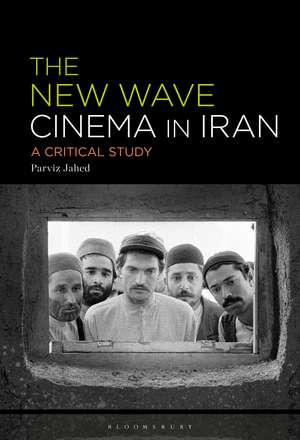The New Wave Cinema in Iran: A Critical Study
Autor Parviz Jaheden Limba Engleză Hardback – 29 iun 2022
| Toate formatele și edițiile | Preț | Express |
|---|---|---|
| Paperback (1) | 191.31 lei 6-8 săpt. | +70.96 lei 6-12 zile |
| Bloomsbury Publishing – 21 feb 2024 | 191.31 lei 6-8 săpt. | +70.96 lei 6-12 zile |
| Hardback (1) | 568.80 lei 6-8 săpt. | |
| Bloomsbury Publishing – 29 iun 2022 | 568.80 lei 6-8 săpt. |
Preț: 568.80 lei
Preț vechi: 815.94 lei
-30% Nou
Puncte Express: 853
Preț estimativ în valută:
108.85€ • 113.50$ • 90.47£
108.85€ • 113.50$ • 90.47£
Carte tipărită la comandă
Livrare economică 21 martie-04 aprilie
Preluare comenzi: 021 569.72.76
Specificații
ISBN-13: 9781501369124
ISBN-10: 1501369121
Pagini: 248
Ilustrații: 51 bw illus
Dimensiuni: 152 x 229 x 22 mm
Greutate: 0.5 kg
Editura: Bloomsbury Publishing
Colecția Bloomsbury Academic
Locul publicării:New York, United States
ISBN-10: 1501369121
Pagini: 248
Ilustrații: 51 bw illus
Dimensiuni: 152 x 229 x 22 mm
Greutate: 0.5 kg
Editura: Bloomsbury Publishing
Colecția Bloomsbury Academic
Locul publicării:New York, United States
Caracteristici
Contains a wealth of primary sources such as conversations with filmmakers and critics
Notă biografică
Parviz Jahed is an independent scholar based in the UK. He is also a film critic, film researcher, filmmaker and lecturer in film studies. He is the editor-in-chief of Cine-Eye, a UK based film journal focused on independent and art cinema, and editor of the Directory of World Cinema: Iran (2012).
Cuprins
Acknowledgements Introduction1. The Iranian New Wave (Mowj-e No)a. Recognition of and challenging Mowj-e No 2. The Internal Factorsa. Cinema and the Negotiation of Modernity in Iran b. The Emergence of National Cinema c. Nativism vs. Westoxication (Gharbzadegi) d. The Enablement and Obstructionism of the State e.The Mechanisms of Censorship f.The Establishment of Cultural Institutions and Film Centres3. Looking for an Alternative Cinema in Irana. Status of Critical Film Discourse in the 1960s Iranb. Intellectual Cinema and Challenging Filmfarsic. New Wave, the Lost Identity and Manifestation of Utopian Cinema4. New Wave and the Literary Traditiona. Adaptation from Persian Classical Literatureb. Later Fantasy and Folktalesc. Interaction between Mowj-e No and Modern Literature5. The External Influencesa. The Footprint of Italian Neorealismb. The Global Impact of the French Nouvelle Vaguec. The French Nouvelle Vague and the Iranian Mowj-e Nod. Freydoun Hoveyda, the Auteur Theory and Iran's New Wave 6. The Forerunners of the New Wave Cinema in Irana. Ebrahim Golestan and Writing with a Camera b. The Legacy of Farrokh Ghaffaric. Fereydoun Rahnema and his Self-Reflexive Cinema7. New Wave Successors and New Film Aesthetics a. Formalistic Approach in Mowj-e Nob. Social Realism and Street Film GenreAfterwordBibliographyIndex
Recenzii
Parviz Jahed provides a fascinating account of the development of Iranian New Wave Cinema, tracing both the local factors behind its emergence and the international influences informing the aesthetic richness of the films. Importantly, Jahed considers how New Wave filmmakers were both hindered and helped by the state and assesses the critical discourses that emerged as a small group of filmmakers attempted to challenge popular cinematic conventions in Iran in the 1960s to establish an intellectual, more artistic cinematic practice.
